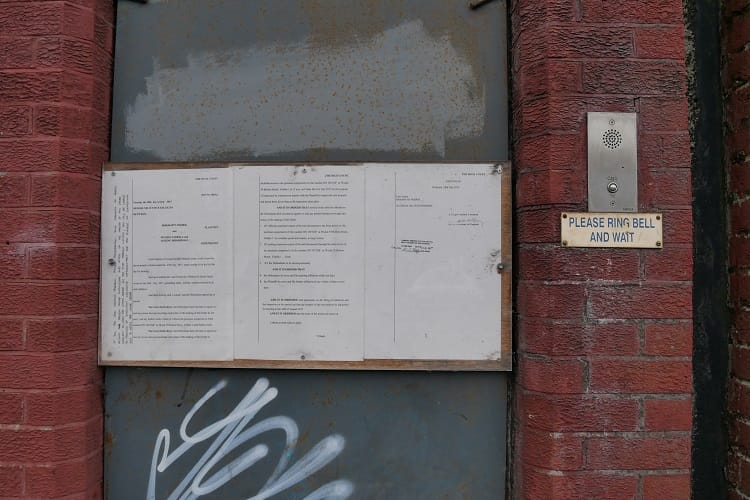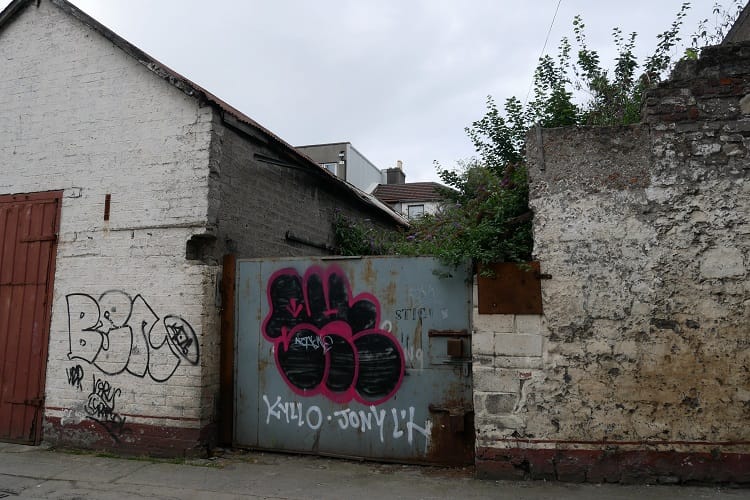What would become of the Civic Offices on Wood Quay if the council relocates?
After The Currency reported the idea of the council moving its HQ, councillors were talking about and thinking through the pros and cons and implications.
For years the council has been saying they will be made into apartments for people who are homeless. But that still hasn’t happened.

Three years ago, when housing activists stood down from their occupation of 38 and 39 Bolton Street after the council took them to court for trespassing, they didn’t feel too bad, says Séamus Farrell.
Dublin City Council had said the buildings – which it owns – would be turned into accommodation for people who were homeless. That was something they could rally behind, said Farrell.
But it hasn’t happened yet.
The two tall buildings in the north inner-city are still empty, with boarded-up windows and shuttered doors, and advertising posters plastered to the front wall.
“It’s not surprising, it’s disappointing,” says Farrell, an activist who was involved at the time. He is now among those who have taken over a Georgian building on Summerhill Parade, motivated in part by a wish to highlight the number of properties lying vacant.
“That could be homes,” he said.
According to a council spokesperson, the council assigned the building to Novas Initiatives, an approved housing body, “some years ago”, with the aim of making it into supported homeless accommodation.
Novas Initiatives, a non-profit which provides housing for the homeless or those at risk of homelessness, applied in December 2014 for permission to partially demolish and redevelop the two properties and put in six one-bed apartments and two two-bed apartments.
That was declared invalid on the grounds that the site location on the application was “insufficient for the information of the public”, say planning records. There was a second application in 2015, but that was withdrawn.
The council got a proposal to redevelop the site in 2016, which noted that Novas Initiatives needed to do a conservation assessment, said the council spokesperson. That needed to be done before the project could progress further.
They’re not on the record of protected structures but do have a local interest and add to the streetscape, and under the development plan the council requires developers to retain and reuse buildings like that, they said.
“There has been no abnormal delay since Dublin City Council received the conservation report,” the spokesperson said.
“It is a very difficult and expensive project because the buildings are in need of total refurbishment,” they said.
Novas Initiatives hired a conservation consultant to do a pre-planning report. And the council’s heritage section has said the buildings are not protected structures, but that Novas should protect as much of the historic fabric as possible, the spokesperson said.
The Department of Housing has approved funding in principle for eight apartments there, as long as it gets planning permission, they said.
But exactly how long that will all take from here is still unclear.

The completion date in council reports has been edged back. In July 2017, a council report said it would be done in 2018. A more recent report in June 2018 said it would be done in 2019.
The council spokesperson said that it expected Novas to submit a formal planning application “shortly”.
Una Burns, head of policy and communications for Novas Initiatives, said though that “it’s going nowhere fast”.
The council and Novas started this project in 2012, she said. It’s at the pre-planning stages – which means that Novas Initiatives is liaising still with the engineers to see if they are happy with the designs, she said.
How long it takes, once they do file for planning permission, is hard to say, she says. “It depends if there are any objections and stuff.”
The sticking point has been the “heritage of the building”, she says. Burns said that any further questions had to go to Dublin City Council.
“At one stage we did consider taking the property back because of the delay but progress has been achieved in recent months,” said the council’s head of housing, Brendan Kenny, in an email to Sinn Féin Councillor Daithí Doolan earlier this week.
Says Doolan: “I think it’s unacceptable that the buildings are lying empty.”
When activists occupied the vacant building in 2015, it drew attention to the fact that it was empty, he said. “Several years have since lapsed.”
Doolan said he isn’t interested in a “blame game” of who is responsible for the delays – just in getting it turned into homes.

The delay “should be of concern to all of us interested in improving levels of homelessness in inner-city Dublin”, says Neasa Hourigan, a Green Party candidate for Dublin Central in the next general election, who is involved in the current occupation of the Georgian terrace on Summerhill Parade.
The council and the approved housing body need to “work together so the cause of the delays is identified and addressed with urgency”, she said.
If delays are at all because of issues around the historic fabric of the building, the council should offer “its full support and expertise to housing agencies and insuring that those agencies have the capacity to undertake the projects they have committed to”, she said.
[UPDATE: This article was updated on 15 August at 11.40am to include comment from the council as to its status as a building of local significance under the development plan.]